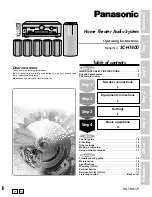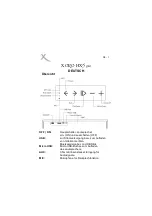
5
RQT6361
Step 1
Step 2
Step 3
Before use
Step 4
Others
Reference
3
2
1
R L
R
L
SPEAKERS
HAUT-PARLEURS
SURROUND
FRONT
CENTER
SUB-
WOOFER
6-8
Ω
/EACH SPEAKER
6-8
Ω
/CHAQUE
6
5
4
3
2
1
1
FRONT L
2
FRONT R
3
CENTER
6
SUBWOOFER
5
SURROUND R
4
SURROUND L
CENTER
FRONT R
FRONT L
SURROUND R
SURROUND L
SUBWOOFER
Connecting the speakers to the receiver
Caution
¡
Use the speakers only with the
recommended system. Failure to do so may
lead to damage the amplifier and/or the
speakers, and may result in the risk of fire.
Consult a qualified service person if damage
has occured or if you experience a sudden
change in performance.
¡
Do not attempt to attach these speakers to
walls using methods other than those
described in this manual.
Attaching to a wall
To attach vertically
Rubber feet
(included)
Rubber feet
(included)
Screw
(not included)
Screw
(not included)
106 mm
(4-11/64")
30–35 mm
(1-3/16" to 1-3/8")
7–9 mm
(9/32" to 23/64")
To attach horizontally
Screw
(not included)
Rubber feet
(included)
Attach four rubber feet to each speaker, ensuring they do not cover
the holes. Screw the wood screw into a thick and hard part of the
wall.
The surface you attach the speakers to must be able to support
over 10 k
g
(22 lb). Consult your dealer for details.
Note
Attaching to speaker stands
Ensure the following conditions are met when you purchase
your speaker stands.
¡
Screw; diameter: 5 mm, pitch: 0.8 mm, length: thickness of stand
plate plus between 7 and 10 mm.
¡
Distance between the centers of the holes; 60 mm
¡
The stands must be able to support over 10 k
g
(22 lb).
¡
The stands must be stable even if the speakers are in a high
position.
Attach the stands
with these holes.
Speaker stands (not included)
5 mm, Pitch 0.8 mm
60 mm
(2-23/64")
Plate thi 7 to 10 mm
(9/32"–25/64")
106 mm
(4-11/64")
30–35 mm
(1-3/16" to 1-3/8")
7–9 mm
(9/32" to 23/64")
Speaker notes
¡
You can damage your speakers and shorten their useful life if you
play sound at high levels over extended periods.
¡
Reduce the volume in the following cases to avoid damage.
– When playing distorted sound.
– When the speakers are receiving howling from a microphone
or record player, noise from FM broadcasts, or continuous
signals from an oscillator, test disc, or electronic instrument.
– When adjusting the sound quality.
– When turning the unit on or off.
;;
;;
;;
;;;
;;;
;;;
Speaker cords
¡
Connect the cords so the numbers on the stickers match the numbers under the terminals.
¡
Connect the red cords to the red terminals (+) and the black cords to the black terminals (–).
¡
Ensure the wire of the cords are fully inserted so they do not touch each other and short circuit.
¡
After you have completed set-up and connection, wind the excess cord and keep together with string.
5






































